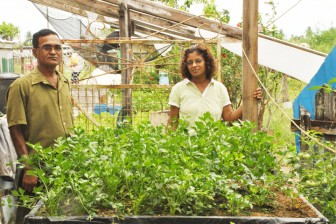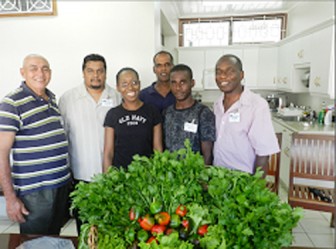Chastened by the challenges associated with traditional approaches to agriculture not least of which are flooding, pests and soil deficiencies, the local agricultural sector has, for some years now, been exploring the potential of hydroponics, a farming method the uses mineral nutrient solutions in water without soil.
The technology employs an inert medium, commonly clay or coconut husk in which the roots of the plant grow.

A number of international donors including Partners of the Americas, Caribbean Self-Reliance International (CASRI) and the Inter American Development Bank (IDB) through its Multilateral Investment Fund (MIF) have thrown their collective weight behind the Shade house Vegetable Production and Marketing Project, an initiative which employs hydroponics to equip rural households and the disadvantaged with sustainable low-cost shade house cultivation capacity that allows for both self-sufficiency and limited marketing.
That might be the stated objective of the project, but its Coordinator, Agricultural Economist Kelvin Craig says the success of the initiative, up to this point, may well have created a critical opportunity to popularize hydroponics as a method of production that can be more widely employed in the agricultural sector as a whole.
Since the launch of the project in March 2010, much has happened to enhance optimism among the members of the implementation team.
Between them, the IDB and CASRI have provided funding for the project totalling US$148,000, of which the IDB provided US$101,500. As agricultural projects go this is a modest investment though, arguably, the returns have been considerable. Since its establishment the project has facilitated the construction of 41 new low-technology shade houses in which to cultivate the vegetables. The initiative embraces farmers from areas as distant from each other as Upper Pomeroon and North Sophia.
What the project has done is to expose approximately 324 individuals to home-based hydroponic vegetable production of which 87 are in operation. While some individuals who have been impacted by the project produce exclusively for domestic consumption, others sell surplus produce including celery, tomatoes, pakchoy and lettuce on what one might call the local market.
It is as much the process as the outcome that Craig finds appealing. Newness can sometimes bring with it a sense of apprehension and the Project Coordinator readily admits that the idea of redirecting their attention to hydroponics did not appeal to all of the farmers. He believes, however, that the challenges afflicting global agriculture, particularly those associated with climate change and pests will recruit more converts to hydroponics.
The investment in a farming method that can – at least in some measure – address some of the challenges associated with land-based cultivation are relatively modest. An 18ft x 24ft shade house, including planting trays can cost approximately $324,000 to erect while the sand and paddy used as substrat in which to anchor the plants cost a further $40,000. Annual operating costs including planting, pesticides and reaping operations cost around $202,000.
Craig credits the project’s field staff, including its Field Coordinator Gavin Gounga with making what he says are “critical visits” to the shade houses in the various regions, visits which have succeeded in making the shade houses commercially viable.
The success which the project has yielded has spawned marketing networks in some regions. In the Essequibo, for example, business houses like Bacchus Fast Food, Xenon, Lords and Purple Heart restaurants are among the prominent buyers of hydroponically grown vegetables. Similar patronage by restaurants and hotels apply in Regions Three and Ten while in Georgetown prominent supermarkets including Nigel’s and Bounty as well as some restaurants also purchase vegetables cultivated in shade houses.
The St Stanislaus College Farm which this newspaper visited earlier this week has an established marketing arrangement with the Bounty outlets.

arketing plans include special promotional initiatives at popular marketplaces. Craig says that project officials are contemplating the creation of special logos and a proposal to engage the media in the branding of hydroponically cultivated produce is in the pipeline. The marketing initiative is scheduled to commence in June this year.
Craig believes the advantages derived from immunity from pests and water-borne diseases coupled with ‘resistance’ to flooding not only provides an important promotional advantage for hydroponically grown vegetables but also offers a greater assurance of consistency of supplies.
Modest success among shade house operators in marketing their produce in the respective regions has encouraged the project team to contemplate an expansion of the marketing programme to embrace larger areas of coastal Guyana. While the shade houses are, in effect, individual commercial ventures, marketing has benefited from networks that have been encouraged by the project itself. Craig is mindful of the challenges associated with marketing produce cultivated in the shade houses, his primary concern being that supplies of produce match the extent of demand once the marketing initiative gets underway.




